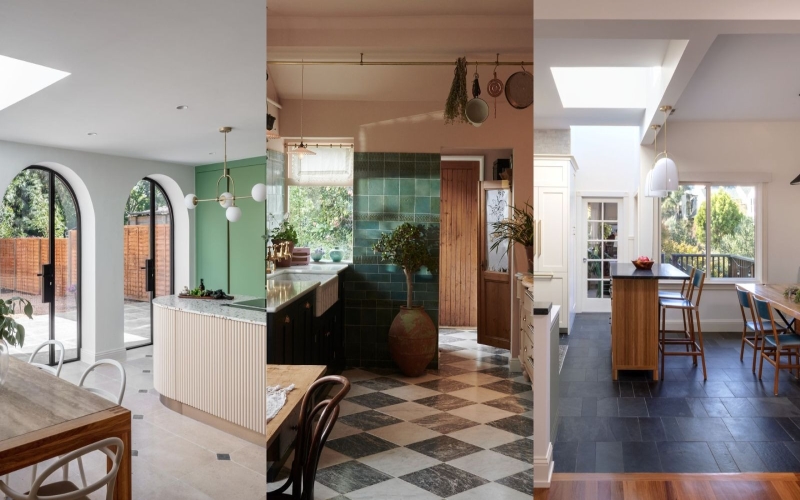In the dynamic world of restaurant design, the open kitchen concept has emerged as a leader, providing diners with an immersive dining experience. This novel technique not only adds openness to the cooking process, but it also presents a distinct set of challenges and opportunities when it comes to picking the correct furniture. Striking the delicate balance between appearance and functionality is critical for creating a seamless and engaging experience for both consumers and employees. In this post, we will look at the nuances of restaurant furniture for open kitchen concepts, including essential considerations, beautiful designs, and practical solutions that enhance the dining experience.
Selecting Restaurant Furniture
When selecting furniture for an open kitchen restaurant, durability and quality are the most important considerations. Choosing materials that can survive the rigors of a busy kitchen is critical. Aside from longevity, restaurant owners should consider heat and wear resistance to ensure that the furniture’s visual appeal lasts over time. It’s also crucial to think of commercial restaurant furniture as a long-term investment, with warranty options and maintenance contracts to protect against unexpected wear and tear.
Comfort becomes an important consideration in the overall dining experience. Ergonomic design is important not only in offices, but also in restaurants. Seating selections should respond to consumers’ different interests, providing a variety of styles that improve comfort and encourage longer stays. Additionally, staff comfort should not be disregarded, as it has a direct impact on productivity. Cushioning and padding can help to improve the overall experience for both consumers and employees.
Versatility and adaptation in furniture design provide more flexibility to the restaurant space. Furniture arrangements should be easily adaptable to varied occasions and changing needs. Multi-functional furniture, such as adjustable-height tables and modular seating alternatives, can improve the space’s versatility. Scalability is also important, as it ensures that the chosen furniture is compatible with prospective business expansion and menu adjustments.
Stylish Designs for Open Kitchen Restaurants
Aesthetics are important in providing a memorable dining experience at open kitchen restaurants. It is critical to incorporate visual aspects that are consistent with the establishment’s overall theme. The furniture should mix in with the restaurant’s decor, producing a consistent visual experience for customers. Customization possibilities allow for a distinct touch, with furniture tailored to the exact peculiarities of the room. Lighting, too, plays an important part in highlighting furniture design and creating the appropriate ambient to enhance the dining experience.
Modern and stylish furniture types provide a contemporary touch to open kitchen restaurants. Sleek and minimalist designs help to create a clean and sophisticated aesthetic that complements the open kitchen’s openness. Fusion styles, which combine contemporary and traditional elements, produce an eclectic ambiance that appeals to a wide range of tastes. Incorporating cultural and regional inspirations into furniture design provides a distinct touch, turning dining into a sensory trip.
Practical Considerations for Open Kitchen Furniture
Practicality is at the heart of choosing furniture for open kitchen concepts. Given the dynamic and frequently dirty nature of a kitchen, ease of maintenance and cleaning is essential. Furniture should be stain and spill-resistant, and cleaning workers should have easy access. Establishing explicit cleaning processes and best practices guarantees that the furniture not only looks excellent but also meets high hygiene standards in an open kitchen setting.
Adequate storage options improve the functionality of the area. Maximizing space efficiency is critical, particularly in a busy kitchen where every square inch counts. Concealed storage alternatives not only keep the room looking nice, but they also help to organize and streamline workflows. Open display storage can be strategically placed to highlight vital kitchen utensils or aesthetically beautiful dishware, bringing visual interest to the room.
Key Factors to Consider in Selecting Restaurant Furniture
Integrating technology into furniture design is a forward-thinking strategy that is consistent with the modern period. Smart tables and seats not only improve the dining experience, but also allow for customer participation. Digital displays built into furniture can provide interactive menus or show the culinary process in real time. The usage of sustainable and eco-friendly materials is increasing popularity, reflecting the growing awareness of environmental responsibility in the hospitality business.
Evolving styles and aesthetics contribute to the ever shifting terrain of restaurant design. Open kitchen restaurant designs are expected to develop toward more holistic and immersive experiences. Innovative ways that combine appearance and functionality are predicted to gain popularity. The combination of traditional and modern inspirations results in settings that appeal to a broad audience. Incorporating local art and workmanship into furniture design enhances authenticity and connects the restaurant to its cultural roots.
Considerations for Restaurant Layout and Space Planning
Efficient space usage in open kitchen designs necessitates precise planning. Strategic furniture placement is critical for maximizing traffic flow and creating distinct functional zones within the restaurant. Thoughtful zoning ensures that the eating area, kitchen, and service areas blend harmoniously. Maximizing seating capacity while maintaining comfort is an art, and furniture selections have a direct impact on the whole spatial experience.
Lighting design is an often overlooked feature of restaurant interiors. Adequate lighting is vital for establishing a welcoming environment. The use of ambient and task lighting, as well as accent lighting to emphasize specific furniture items, enhances the overall mood. Integrating natural light into open kitchen spaces improves the dining experience by creating a sense of connection to the outside environment.
Navigating the Future of Open Kitchen Restaurant Furniture
As the restaurant industry evolves, open kitchen concepts continue to drive innovation. The furniture chosen for these places has a significant impact on the overall dining experience. Striking a balance between appearance and functionality is more than just a design problem; it’s a strategic decision that can affect customer satisfaction and operational efficiency. The key to navigating the future of open kitchen restaurant furniture is adaptability, innovation, and a thorough awareness of changing patron preferences and industry trends. By embracing these principles, restaurant owners can design rooms that not only reflect their own personality but also give their guests with an exceptional dining experience.





